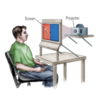Chapter 11 Flashcards
(88 cards)
cerebral asymmetry
anatomical, physiological, or behavioral differences between the two cerebral hemispheres
laterality
two cerebral hemispheres have separate functions
challenges to studying cerebral asymmetry
- laterality is relative
- both hemispheres participate in nearly every behavior
- environmental and genetic influence on laterality
- cerebral organization of some left handers and females appears less asymmetrical than that of right-handers in males
- a range of animals with asymmetrical brains
- songbirds, rats, cats, and monkeys
major anatomic differences between two hemispheres
identified with MRI
- rt hemi: slightly larger and heavier; lt hemi: contains more gray matter (neurons)
- temporal lobes: specialization
- left: language
- right: music functions
- temporal lobe & thalamus:
- anatomical asymmetry in the temporal lobe’s cortex correlates with an asymmetry in the thalamus
- structural asymmetry compliments apparent functional asymmetry of the thalamus
- left thalamus, like left hemi, also dominant for language functions
- frontal operculum (Broca’s area):
- organized differently on left and right hemisphere
- left side: area of cortex buried in the sulci is greater
- grammar production
- right side: area visible on surface is 1/3 larger
- tone of voice (prosody)
- lateralization of the functions
- lateral fissure: slope of lateral fissure is gentler on the left hemisphere than on the right
- tempororparietal cortex lying ventral to lateral fissure appears larger on the right

neocortical asymmetry
describe
- overall neocortical surface area was the same in both hemispheres
- rt hemisphere: extends further anteriorly than the left
- lt hemisphere: extends farther posteriorly than the right
- overall pattern of asymmetry is evident across both hemispheres
neocortical asymmetry
largest asymmetry favored
- left hemi: in Sylvian and medial temporal regions
- right hemi: in posterior parietal and dorsal lateral pre-frontal areas
neocortical asymmetry
occipital horns of the lateral ventricles
5x likely to be longer on the right side than on the left
neuronal asymmetries
- dendritic fields of pyramidal cells have abundant branches in Broca’s area (left frontal operculum)
- neurons in each region have a distinct pattern of the dendritic branching
- important bc: each branch is a potential location for enhancing or suppressing neuronal communication → more branch points = cells w more degrees of freedom w respect to function

gene asymmetries
- human genome project
- genes expressed differently in the two hemispheres
- epigenetic changes mimic their relationship between genes
- experience may differentially influence the two hemispheres
lateralized =
= dissociated
double dissociation
- two neocortical areas are functionally dissociated by two behavioral tests
- performance on each test is affected by a lesion in one zone but not in the other
hemisphere double dissociation ex
- left-hemi lesions: (rt-handed patients) produce deficits in language functions – speech, writing, and reading, that are not produced by right-hemisphere lesions
- → the two hemispheres’ functions are dissociated
- rt hemi lesions: performing spatial tasks, singing, playing musical instruments, and discriminating tonal patterns,
- Because a right-hemisphere lesion disturbs tasks that are not disrupted by left-hemisphere lesions and vice versa, the two hemispheres are doubly dissociated.

case study: double dissociation
conclusion
- Subsequent to removal of the left temporal lobe, PG was impaired only on verbal tests
- Subsequent to removal of the right temporal lobe, SK was impaired only on nonverbal tests.
- Both patients performed normal on many tests providing evidence for localization as well as for lateralization of functions

case study: double dissociation
PG
- patient A, PG
- 31 yo man, developed seizures in 6th year preceding neurosurgery, seizures poorly controlled by medication and subsequent neurological investigations revealed large tumor in anterior part of left temporal lobe
- preoperative tests: superior intelligence, significant deficits in verbal memory
- left temporal lobectomy
- decreased intelligence ratings
- further decreased verbal memory scores
case study: double dissociation
SK
- patient B, SK
- preoperative scores: low score on recall of complex drawing
- right temporal lobectomy
- decreased intelligence ratings
- decreased nonverbal memory scores for simple and complex designs
commissurotomy
- surgical disconnection of the two hemispheres by cutting the corpus callosum
- to prevent the spread of a seizure when meds fail
epileptic seizures
may begin in a restricted region of one hemisphere and spread through the fibers of the corpus callosum, the commissure, to the homologous location in the opposite hemisphere
after commissurotomy
split brain
- two hemisphere independent, can’t communicate
- each receives sensory input from all sensory system and each can control body’s muscle
- sensory info can be presented to one hemisphere, and its function can be studied without the other hemi having access
- right hemi: reasonably good recognition ability, but cannot initate speech (bc lacks access to speech mechanisms in left)
- have a physical key → they can grab it

how vision is affected by split brain
- input from left visual field goes to right hemi
- input from right visual field goes to left hemi
how speech is affected by split brain

when left hemi of split brain pt has access to info
it can initiate speech and communicate about the info
when right hemi of split brain pt has access to info
can recognize but cannot initiate speech

split brain patients - faces
- unaware of the gross discordance between the pictures two sides
- right hemisphere plays special role in recognizing faces
tachistoscope
- visual info can be presented to each visual field independently
- information presented to only one visual field is processed most efficiently by the hemisphere specialized to receive it


















